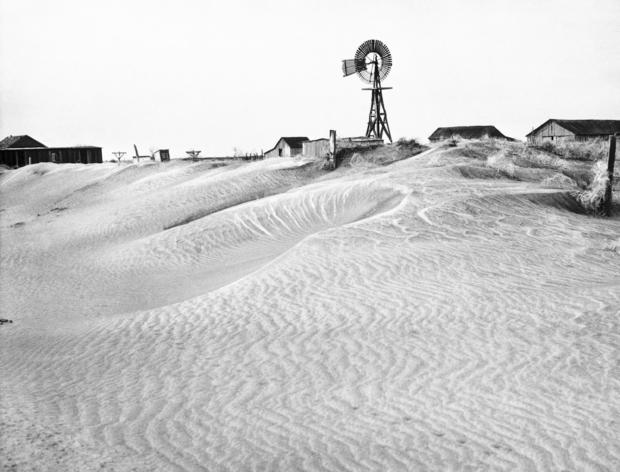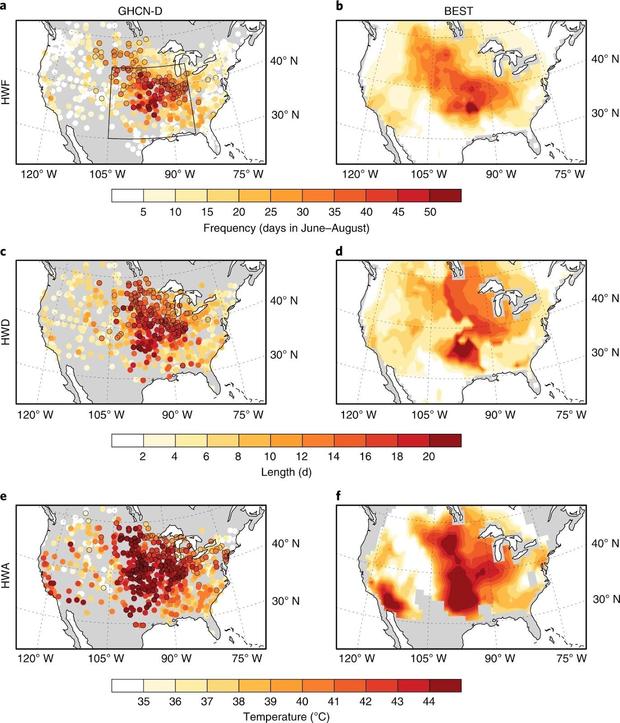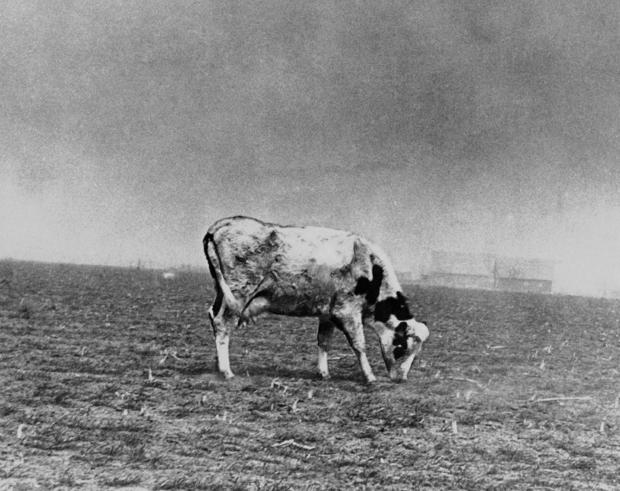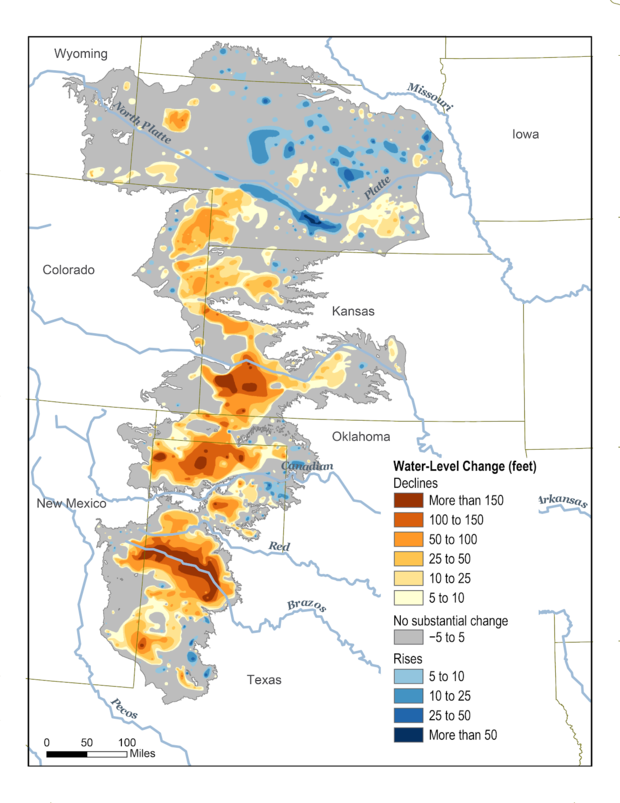Dust Bowl Can It Happen Again
A devastating Dust Bowl heat wave is now more than twice as likely, study says
The Great Plains Dust Bowl of the 1930s was arguably the most devastating ecological disaster in American history, turning prairies into deserts and whipping up killer dust storms. The catastrophe was partly manmade — driven by decades of land mismanagement — and fueled by brutal estrus waves and years of relentless drought.
More than 8 decades later on, the summer of 1936 remains the hottest summer on record in the U.Due south. However, new inquiry finds that the heat waves that powered the Dust Bowl are now 2.v times more probable to happen once again in our modern climate due to some other type of manmade crisis — climatic change.
Even though information technology seemed like a natural disaster, the background for much of the suffering acquired by the Dust Bowl was laid by humans.
Until the late 1800s the Great Plains were covered by endless acres of native grasslands, well attuned to the unique climate of the region. That had all inverse by the turn of the 20th century, equally a serial of federal land acts enticed pioneers to motility to the region and fix farms with the promise of free or cheap land.
With cold winters, hot summers and a dry, windy climate, the expanse was considered marginal farmland. But with need from a growing wheat and cattle market, farms quickly replaced deep-rooted grasslands, which normally helped to trap soil and wet fifty-fifty during droughts.
The decimation of native grasslands led to a significant loss of both soil moisture and the ability to continue soil in place. It is estimated that three to four inches of topsoil was blown away during the 1930s. To make matters worse, some relatively inexperienced farmers engaged in deep plowing of virgin topsoils and enabled overgrazing.
This absence of sound country direction led to a feedback loop, where the lack of vegetation and moist soils meant the land no longer had the ability to cool itself through evaporation. And so when natural climate fluctuations in the Atlantic and Pacific Oceans led to a streak of years with oestrus and drought in the Plains, the country not only had no buffer, but actually acted to amplify the disaster.
The authors of the study found that even way back then, emissions had already started to influence the climate. "These extremes occurred during a period of multidecadal warming, with early twentieth century global-scale drought probable amplified by greenhouse gases," they write.
The 1936 rut moving ridge was and then extreme it is considered a once-in-100-year event, with 25% of all U.S. daily heat records set up during that summer and half of such records set during the 1930s. Temperatures routinely topped 110 degrees Fahrenheit.
The images below show the area covered by the 1936 heat wave, and from top to bottom: the number of days with extreme heat, the length of the longest heat wave stretch, and the hottest temperatures recorded.
When the Dust Basin hit, day turned into nighttime as biblical dust storms buried parts of roads and buildings, especially in parts of Kansas, Oklahoma and Texas. On "Black Dominicus" in the Oklahoma Panhandle — Apr 14, 1935 — Thelmas Bemount Campbell described her terror to author Amy Dee Stephens every bit a dust tempest enveloped her dwelling:
"Nosotros could meet information technology rolling toward us at a terrific speed like a prairie burn down. The wind was so potent that nosotros heard later on information technology had cleaved the current of air gauges…When it striking, everything became very still and nosotros were enveloped in this terrible blackness. Nosotros couldn't see our mitt in front of our face up. Some people thought they had been struck blind."
As the grit storms became larger and more intense, children developed fatal "grit pneumonia" and business owners, already reeling from the Not bad Low, were devastated, some driven to suicide and others forced to abscond with their families in a mass exodus. In total, the Grit Bowl killed around seven,000 people and left 2 million homeless.
The heat, drought and dust storms besides had a cascade effect on U.S. agriculture. Wheat production fell by 36% and maize production plummeted by 48% during the 1930s.
The Dust Bowl is an example of an environmental disaster conspicuously made worse by the unintended consequences of human being. And the study concludes that climate alter may shortly bring nearly the next one: "It is likely that the 1930s records will be cleaved in the nearly-futurity even if there is activity to mitigate emissions."
To arrive at their conclusion, the researchers ran thousands of calculator model simulations of the 1930s heat waves, but with atmospheric greenhouse gas concentrations at today's levels.
The study used a novel climate model developed at the University of Oxford that does not run on supercomputers, only rather on the personal computers of volunteers from around the world. This technique suited their particular 1930s heat moving ridge investigation because thousands of simulations could be conducted for each Dust Basin year.
The simulations showed that as a upshot of quickly increasing estrus-trapping greenhouse gases, the 1-in-100-twelvemonth 1936 estrus wave is, at the very least, now more of a 1-in-40-twelvemonth result for the Corking Plains — pregnant a heat wave of that magnitude is now more than twice as probable and could occur twice in the average person's lifetime.
Lead writer of the report Dr. Tim Cowan, of the University of Southern Queensland in Australia, cautions that even this 40-yr return menses is likely an underestimate, and in the time to come extreme heat waves volition occur even more often.
Only given the rise in greenhouse gases over many decades, CBS News asked Cowan why we oasis't already seen a return of Dust Bowl-like conditions in the Great Plains. Cowan explains that the answers lie in the modernistic-day watering of crops. "Groundwater is used quite extensively across the U.S., and we know, from previous enquiry, that increased irrigation and agronomical intensification has led to cooler summer maximum temperatures," he said.
Simply Cowan'south work suggests that our luck volition eventually run out, either when natural weather condition and manmade climate change conspire to overwhelm the cooling influence of irrigation or when groundwater is sufficiently depleted.
In the western Great Plains the majority of groundwater comes from one of the world's largest aquifers -- the Ogallala Aquifer, which runs from Nebraska to Texas. Merely in contempo decades, h2o is being extracted much faster than it is being replenished. Well outputs in the central and southern parts of the aquifer are declining due to excessive pumping, and prolonged droughts have parched the area, bringing dorsum Dust Bowl-manner storms.
According to the federal government'south 2018 National Climate Assessment, parts of the Ogallala Aquifer should be considered a nonrenewable resource.
As a event, Cowan warns, "Dwindling water availability in regions of depression groundwater recharge may hateful that cooler summertime conditions may switch to warmer temperatures in decades to come up under the influence of rising greenhouse gas emissions."
If these Grit Basin conditions do return, scientists say we should prepare for a shock to the nutrient system. A recent study predicted that the U.S. would exhaust 94% of its wheat reserves in a iv-year Grit Basin-similar upshot. This would lead to a 31% loss of global wheat stocks.
Besides the impacts on food systems, an April study from the University of Washington finds the expected increase in extreme heat volition also be a wellness shock. The research warns of danger for agronomical pickers in the U.S., with unsafe piece of work days more than than doubling past 2050 and heat waves happening five times more oftentimes every bit the planet continues to warm.
The lesser line, Cowan says: "It is likely that at that place volition be more than extreme estrus wave conditions in the key U.S. in the future, given the rise in greenhouse gases levels, so communities and governments demand to exist prepared for this eventuality."
Source: https://www.cbsnews.com/news/dust-bowl-heat-wave-climate-change-twice-as-likely-study-says/





0 Response to "Dust Bowl Can It Happen Again"
Post a Comment